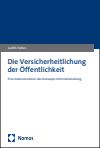Zusammenfassung
Der Krieg, in dem wir uns heute laut Militär, Politik, Denkfabriken und Medien unter anderem befinden, ist ein „Informationskrieg“. Mittels Sprache, Kommunikation und der globalen Vernetzung durch den digitalen Raum werden die (Zivil-)Gesellschaft, ihre Werte, Normen und Zielvorstellungen angesprochen. Die langfristige Strategie ist die Spaltung der Gesellschaft. Denn eine gespaltene Gesellschaft ist eine angreifbare, subversiv leicht zu (zer-)störende und damit als staatliches Gebilde handlungsunfähige Gesellschaft. Diesem Bedrohungsszenario folgt das Konzept „Informationskrieg“, welches von der Autorin analysiert und anhand des Krieges in der Ukraine hinterfragt wird.
Abstract
According to the military, politicians, think tanks and the media, modern societies are part of ongoing 'information warfare'. Cyberspace allows military operations to address (civil) society, its values, norms and goals through language, communication and global networking. Its goal is to divide societies because a divided society is vulnerable and easy to destroy subversively, and therefore incapable of acting as a state structure. This threatening scenario is followed by the concept of 'information war', which is analysed in this work in terms of its implications and any actions derived from it.
Schlagworte
Bedrohungsszenario civil society defense policy Destabilisierung von Gesellschaften destabilization of societies Destabilisierung von Staaten destabilization of states Geopolitik hybride Kriegsführung geopolitics hybrid warfare Informationskrieg Sicherheitspolitik information warfare security policy Spaltung der Gesellschaft societal division Ukrainekrieg threat scenario Verteidigungspolitik Ukraine war Zivilgesellschaft- 119–138 4. Der gesellschaftliche Raum der Identitätskonstruktion: Öffentlichkeit und Demokratie 119–138
- 139–162 5. Die Militarisierung gesellschaftlicher Infrastruktur: Information und Kommunikation 139–162
- 163–192 6. Die Naturalisierung gesellschaftlicher Artefakte: (Cyber-)Raum und Informationsumfeld 163–192
- 267–290 10. Literatur 267–290

